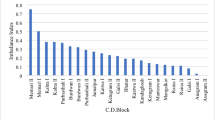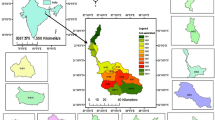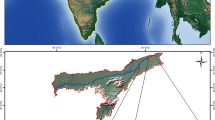Abstract
Background
Enset-based land use system (EBLUS) exhibits good carbon stock and infiltration rate equivalent to forest covered areas, which enhances infiltration rate and water holding capacity of the soil and it can also reduces the curve number (CN) of the soil but it was not considered in former studies in Meki river watershed. Therefore, this study was planned to articulate the influence of EBLUS on infiltration rate and CN of the soil and also to interpolate the CN matrix of EBLUS relative to other LUSs with established hydrological characteristics in the watershed. The soil type data collected from Ministry of Water, Irrigation and Energy (MOWIE) and verified by Harmonized World Soil Database (HWSD) was used to determine the Hydrologic soil group (HSG) of the watershed. Land cover considering EBLUS was classified using ERDAS Imagine 2014 while other watershed parameters were generated from Digital Elevation Model (DEM). Infiltration rate of the soil was measured using Amozi-meter (Hood infiltro-meter) under different LUSs and considered in EBLUS CN matrix interpolation. HEC-Geo-HMS model, Geo-statistical tool, SPSS and MS-Excel were used to interpolate CN matrix of EBLUS relative to other LUSs.
Result
The field measurement results show that an infiltration rate of 12.9675, 11.1875, 10.375, 7.065 and 12.8125 mm h−1 for Natural Forest LUS, Grassland and plantation LUS, cultivated LUS, Bare/built-up LUS and EBLUS, respectively. The resulting CN matrix of EBLUS was 39, 51.5, 58.3 and 61.6 for HSG of A, B, C and D, respectively. There was higher infitration rate and lower CN matrix in EBLUS relative to other land use systems with formerly established hydrological parameters.
Conclusion and recommendations
The relatively high infiltration rate of the soil and a significant reduction in mean CN of the watershed shows the high role of EBLUS in water resources management. Therefore, escalating EBLUS will increase infiltration rate and reduce the CN of the soil which reduces runoff volume in the watershed and it ensures the sustainability of water bodies such as Lake Ziway by reducing sedimentation.












Similar content being viewed by others
Availability of data and material
Data are acquired from Ministry of Water, Irrigation & Electricity (MOWIE) of Ethiopia for flow data, Ethiopian Meteorological Agency (EMA) for meteorological data, Ethiopian Central Statistical Agency (ECSA) for population data, Ethiopian Geospatial & Mapping Agency (EGMA) for Satellite images and topo-maps, Satellite images from USGS earth explorer and field materials acquired from Ethiopian Institute of Water Resources (EIWR) in Addis Ababa University.
Abbreviations
- DEM:
-
Digital elevation model
- EBLUS:
-
Enset-based land use system
- EGSIA:
-
Ethiopian geospatial information agency
- ENMA:
-
Ethiopian National Meteorological Agency
- ERA:
-
Ethiopian Road Authority
- ERDAS:
-
Earth resources data acquisition system
- GIS:
-
Geographical information system
- GPS:
-
Geographical positioning system
- HEC-GEO-HMS:
-
Hydrologic Engineering Center’s Geospatial Hydrologic Modeling System
- HEC-HMS:
-
Hydrologic Engineering Center’s Hydrologic Modeling System
- HSG:
-
Hydrologic soil group
- HWSD:
-
Harmonized World Soil Data
- LULCC:
-
Land uses and land cover change
- LUSs:
-
Land use systems
- m.a.s.l.:
-
Meter above sea level
- MOWIE:
-
Ministry of water, irrigation and energy
- SCS-CN:
-
Soil conservation services curve number
References
Anita S, Haile B, Tesfaye S, Abebe Y, Amaldegn A, Tabogie E (1996) Enset farming systems in Southern Region, Ethiopia, vol 83. Report on a Rapid Rural Appraisal in Gurage, Hadiya and Sidama Zones, University of Florida. Deutsche Gesellschaft for Technische Zusammenarbeit (GTZ)
Barbora DS, Jaroslava V (2014) Effect of various compost doses on the soil infiltration capacity
Bens O, Wahl NA, Fischer H, Hüttl RF (2006) Water infiltration and hydraulic conductivity in sandy cambisols: impacts of forest transformation on soil hydrological properties. Eur J for Res 126(1):101–109
Woldesenbet AB, Wudmatas SD, Denboba MA, Gebremariam AG (2020) Enset-based land use land cover change detection and its impact on soil erosion in Meki river watershed, Western Lake Ziway Sub-Basin, Central Rift Valley of Ethiopia. Int J Environ Syst Res J 9:37
Bridge (1992) The lesion nematode pratylenchusgoodeyi, an important pest of Ensete in Ethiopia. Trop Pest Manag 38(3):325–326
Burch GJ, Bath RK, Moore ID, O’Loughlin EM (1987) A comparative hydrological behavior of forested and cleared catchments in south eastern Australia. J Hydrol 90:19–42
Chow VT, Maidment DR, Mays GW (1988) Applied hydrology. New York St. Louis San Francisco Auckland Bogota Caracas Lisbon London Madrid Mexico City Milan Montreal New Delhi San Juan Singapore Sydney Tokyo. McGraw-Hill, Inc., Toronto
Deng L, Zhu G, Tang Z, Shangguan Z (2016) Global patterns of the effects of land-use changes on soil carbon stocks. Glob Ecol Conserv 5:127–138. https://doi.org/10.1016/J.GECCO.2015.12.004
Elfert S, Bormann H (2010) Simulated impact of past and possible future land use changes on the hydrological response of the Northern German lowland ‘Hunte’ catchment. J Hydrol 383:245–255
Elias E (2011) Soil nutrient evaluation under different land use types in the smallholder farming systems of Jimma Zone, Ethiopia. Int J Agric Res 6(9):707–713
ENMA (2017) Ethiopian National Meteorological Agency data analysis, Addis Ababa, Ethiopia
Ethiopian Road Authority (2013) Drainage design manual. Addis Ababa, Ethiopia
Feddema O, Bonan M, Buja M et al (2005) The importance of land-cover change in simulating future climates. Science 310(5754):1674–1678
Feleke S (2003) Determinants of Food Security in Southern Ethiopia. American Agricultural Economics Association Meetings in Montreal, Canada, 1–29
Fleming MT, Brauer T (2018) Hydrologic Modeling System HEC-HMS Quick Start Guide, US Army Corps of Engineers, Institute of Water Resources, Hydrologic Engineering Center
Ghaffari G, Keesstra S, Ghodousi J, Ahmadi H (2010) SWAT-simulated hydrological impact of land-use change in the Zanjanrood Basin, Northwest Iran. Hydrol Process 24(7):892–903
Harrison J (2014) A draft genome sequence for enseteventricosum, the drought-tolerant “Tree Against Hunger.” Agronomy 4:13–33
Ibeje AO (2018) Impact of land use on infiltration. World J Eng Res Technol 4(6):95–102
Khaddor I, Alaoui AH (2014) Production of a curve number map for hydrological simulation—case study: Kalaya Watershed located in Northern Morocco. Int J Innov Appl Stud 9(4): 1691–1699. ISSN 2028-9324 © 2014 Innovative Space of Scientific Research Journals http://www.ijias.issr-journals.org/
Mbow C, Van Noordwijk M, Luedeling E, Neufeldt H, Minang PA, Kowero G (2014) Agroforestry solutions to address food security and climate change challenges in Africa. Curr Opin Environ Sustain 6:61–67
MOWIE (2013) Strategic agenda for adaptation to urban water-mediated impacts of climate change in Addis Ababa. Federal Democratic Republic of Ethiopia, Addis Ababa
Nejadhashemi AP, Wardynski BJ, Mantha PS (2011) Evaluating the impacts of land use changes on hydrologic responses in the agricultural regions of Michigan and Wisconsin. Hydrol Earth Syst Sci Discuss 8:3421–3468 (2011). www.hydrol-earth-syst-sci-discuss.net/8/3421/2011/. https://doi.org/10.5194/hessd-8-3421-2011
Nyssen J, Temesgen H, Lemenih M, Zenebe A, Haregeweyn N, Haile M (2008) Spatial and temporal variation of soil organic carbon stocks in a lake retreat area of the Ethiopian Rift Valley. Geoderma 146:261–268
Qiu Y, Jia Y, Zhao J, Wang X, Bennett J, Zhou Z (2010) Valuation of flood reductions in the Yellow River Basin under land use change. J Water Res PL-ASCE 136(1):106–115
Rejman J, Rafalska-Przysucha A, Rodzik J (2014) The effect of land use change on transformation of relief and modification of soils in undulating loess area of East Poland. Sci World J 2014:341804
Remo JW, Pinter N, Heine R (2010) The use of retro- and scenario-modeling to assess effects of 100 + years river of engineering and land-cover change on Middle and Lower Mississippi River flood stages. J Hydrol 376(3–4):403–416
Sahle M (2012) Creating SCS Curve Number Grid using HEC-GeoHMS. School of Civil Engineering, Purdue University. vmerwade@purdue.edu, 1–26
Sahle M, Saito O, Fürst C, Yeshitela K (2017) Quantification and mapping of the supply of and demand for carbon storage and sequestration service in woody biomass and soil to mitigate climate change in the socio-ecological environment. Sci Total Environ 624:342–354
Schilling KE, Jha MK, Zhang YK, Gassman PW, Wolter CF (2008) Impact of land use and land cover change on the water balance of a large agricultural watershed: historical effects and future directions. Water Resour Res. https://doi.org/10.1029/2007WR006644
Tilahun A, Robert D (2006) Improved decision-making for achieving triple benefits of food security, income and environmental services through modeling cropping systems in the Ethiopian Highlands. African Highlands Initiative (AHI) working paper no. 20.
Tsegaye A (2007) Effect of repetitive transplanting and leafe pruning on growth and dry matter partitioning of Enset. Agronomy 6(1):45–52
Tsegaye A, Struik PC (2003) Growth, radiation use efficiency and yield potential of enset (Ensete ventricosum) at different sites in southern Ethiopia. Ann Appl Biol 142:71–81
Tu J (2009) Combined impact of climate and land use changes on stream flow and water quality in eastern Massachusetts, USA. J Hydrol 379:268–283
Uloro Y, Mengel K (2014) Response of Enset (Ensetventricosum W.) to mineral fertilizers in southwest Ethiopia, SUdanlage 35390. Institute of Plant Nutrition of the Justus Liebig University, Giessen
United States Department of Agriculture, Natural Resources Conservation Service (USDA-NRCS) (1986) “Urban Hydrology for Small Watersheds”; Technical Release 55, United States Department of Agriculture, Natural Resources Conservation Services, Conservation Engineering Division, Washington, DC, USA
Vaezi AR, Bahrami HA, Sadeghi SHR, Mahdian MH (2010) Modeling relationship between runoff and soil properties in dry-farming lands, NW Iran. Hydrol Earth Syst Sci (HESS) 7:2577–2607. https://doi.org/10.5194/hessd-7-2577-2010
Wang G, Liu J, Kubota J, Chen L (2007) Effects of land-use changes on hydrological processes in the middle basin of the Heihe River, northwest China. Hydrol Process 21:1370–1382
Wang Q, Wang S, Yu X (2011) Decline of soil fertility during forest conversion of secondary forest to Chinese fir plantations in subtropical China. Land Degrad Dev 22:444–452
Ward PJ, Renssen H, Aerts JC, Van Balen RT, Vandenberghe J (2008) Strong increases in flood frequency and discharge of the River Meuse over the late Holocene: impacts of long-term anthropogenic land use change and climate variability. Hydrol Earth Syst Sci 12(1):159–175
Wolka K, Tadesse H, Garedew E, Yimer F (2015) Soil erosion risk assessment in the Chaleleka wetland watershed, Central Rift Valley of Ethiopia. Environ Syst Res 4:5. https://doi.org/10.1186/s40068-015-0030-5
Yimer F (2008) Effects of different land use types on infiltration rate in a catchment in the highlands of Ethiopia. Soil Use Manag 24:344–349
Yirmaga MT (2013) Improving the indigenous processing of Kocho, an Ethiopian traditional fermented food. Nutr Food Sci 3(1):1–6
Zehetner F, Miller WP (2006) Erodibility and runoff-infiltration characteristics of volcanic ash soils along an altitudinal climosequence in the Ecuadorian Andes, Catena. CATENA 65:201–213
Zeiger M, Fohrer N (2009) Impact of organic farming systems on runoff formation processes—a long-term sequential rainfall experiment. Soil till Res 102:45–54
Acknowledgements
We gratefully acknowledge the contributions of Dr. Feleke Zewge and Dr. Bikila from Addis Ababa University, College of Natural and Computational Sciences and Mr. Mamo Kassegn from Ethiopian Institute of Water Resources. We would like also to thank Azage G. Yohannes (PhD) for his genuine help and contribution to our needs. Unfortunately, we feel so troubled whenever we remember his sudden passing away. We want to express our greatest appreciation to Ministry of Water, Irrigation and Energy (MOWIE) of Ethiopia and National Meteorological Agencies (NMA), Ethiopian Central Statistical Agency (ECSA), Ethiopian Geospatial & Mapping Agency (EGMA) and Ethiopian Institute of Water Resources (EIWR) of Addis Ababa University for providing necessary data, materials, equipment and information for this study. This research was also supported in part by thematic research fund of Addis Ababa University, College of Natural and Computational Sciences, Department of Plant Biology and Biodiversity Management and also supported by student fund from Ethiopian Institute of Water Resources (EIWR) in Addis Ababa University.
Funding
Our research is funded by Addis Ababa University (Student grant and thematic research fund).
Author information
Authors and Affiliations
Contributions
Authors in this article made substantial contributions to the conception and design of the work; the acquisition, analysis and interpretation of data and finally have drafted the work or substantively revised it together and the authors read and approved the final manuscript.
Corresponding author
Ethics declarations
Conflict of interests
The authors declare that they have no competing interests.
Originality of work
We assure that, this paper is the original work and have not been presented for a degree in any other university, and all sources of material used for this paper have been duly acknowledged.
Ethics approval and consent to participate
Not applicable.
Consent for publication
Not applicable.
Additional information
Publisher's Note
Springer Nature remains neutral with regard to jurisdictional claims in published maps and institutional affiliations.
Rights and permissions
About this article
Cite this article
Woldesenbet, A.B., Wudmatas, S.D., Denboba, M.A. et al. Effects of enset-based land use system on infiltration rate and curve number of the soil in Meki river watershed, Western Lake Ziway Sub-Basin, Central Rift Valley of Ethiopia. Sustain. Water Resour. Manag. 8, 87 (2022). https://doi.org/10.1007/s40899-022-00667-4
Received:
Accepted:
Published:
DOI: https://doi.org/10.1007/s40899-022-00667-4




